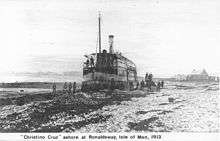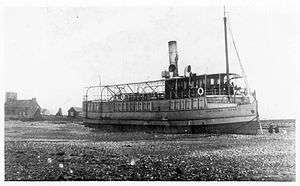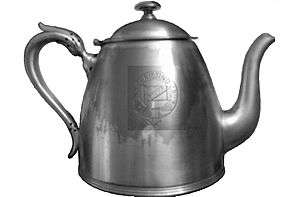TSS Christino Cruz
 | |
| History | |
|---|---|
| Name: | Christino Cruz |
| Owner: | Companhia de Navegação a Vapor do Rio Parnahyba - CNVP (Steam Navigation Company of the Parnahyba River), Teresina, Piauí, Brazil |
| Builder: | Lytham Shipbuilding & Engineering Company, Lytham St Annes, Lancashire |
| Cost: | £8,400 |
| Launched: | 18 January 1913 |
| Fate: | Out service (unknown date and reason) |
| General characteristics | |
| Tonnage: | 178,29 tons |
| Length: | 35.2 m (115 ft) |
| Beam: | 7.0 m (23.0 ft) |
| Draught: | 1.2 m (3.9 ft) |
| Decks: | 3 |
| Installed power: | 350 horse power |
| Propulsion: | Vertical surface condensing twin screw engines of 350 horse power |
| Speed: | 11 knots |
| Boats & landing craft carried: | one lifeboat measuring 18 feet by 6 feet by 2 1/2 feet, fully equipped, including a compass, and capable of carrying all the crew |
| Complement: | 12 crew and passengers |
| Sensors and processing systems: | 1 compass, supplied and adjusted by John Bruce & Sons of Liverpool |
| Notes: | one single-ended return tube boiler fired from the foremost end, loaded to 150 lbs. pressure. |


The TSS Christino Cruz [8] was a twin screw tunnel steamship built of steel by the Lytham Shipbuilding and Engineering Co., Ltd.[9] at Lytham,[3] for the Companhia de Navegação a Vapor do Rio Parnahyba - CNVP (Steam Navigation Company of the Parnahyba River), Teresina, Brazil, for whom Messrs. R. Singlehurst & Co.,[10] Liverpool, were the agents. She was intended for river service as a commercial passenger-carrying coal-fired steamship and was sailed under the Brazilian flag, having a provincial certificate of Nationality issued by the Brazilian Consul in Liverpool.
The riverboat was described on the builders' certificate as having three decks, and one mast, and was cutter rigged. She was clincher built with an elliptical stern and straight stem. Her length was 115.5 feet, main breadth 23.1 feet, with depth in hold from tonnage deck to ceiling amidships, 4.45 feet. Her gross tonnage was 178.29 tons and net register tonnage 121.24 tons. She had two decks, the main deck was of steel and the promenade deck of teak which did not run the whole length of the vessel. The third deck or sun deck was to be laid on her arrival in Brazil. The space between these decks was boarded up for the voyage. The vessel had vertical surface condensing twin screw engines of 350 estimated horse power, designed to give her a speed of 11 or 11 1/2 knots. She had one single-ended return tube boiler fired from the foremost end, loaded to 150 lbs. pressure. She was fitted with both hand and steam steering gear worked from the fore end of the promenade deck by means of chains and rods to the rudder head which was carried up to that level.[1]
She was incorporated to the fleet of CNVP [11] when the company's managing director and owner was the entrepreneur and exporter José Mentor Guilherme de Mello. The vessel was the first of the fleet (until then) to cross the Atlantic Ocean, sailing from Lytham / Preston (next to Liverpool),[3] United Kingdom (where it was manufactured), to Tutóia, on the Parnaíba River delta,[12] Brazil.
Christino Cruz was christened with this name as a tribute to Christino Cruz, agronomist and congressman from the brazilian state of Maranhão,[13] who was also honorary president of the Sociedade Nacional de Agricultura (Brazilian National Society of Agriculture).[14][15][16]
A curious fact happened to the ship on February 6, 1913, early in her first attempt to cross the Atlantic Ocean from Preston bound for Tutóia. According to the detailed "BOT Wreck Report for Christino Cruz, 1913 - No. 7601, of 12 June 1913, produced by the Board of Trade,[1] and records of the Manx National Heritage,[17] the wind and seas were too heavy for the ship and she began to drift backwards. At noon she was sighted off The Stack at Scarlett, which she narrowly missed. And drifting backwards she crossed the Castletown bay. The Castletown lifeboat was launched but by the time she was on the coast just beyond Hango Hill [2] it was too shallow for the lifeboat. The steam boat ran aground and the crew were taken off by the Castletown rocket brigade. Attempts to refloat her were unsuccessful and on 21 February they used greased poles to roll her lower down the beach. She was taken into Castletown harbour for minor repairs before two tugboats took her back to the UK on 22 February. The event proved to be of interest to the people of Castletown and to the lads of the King William's College, near the beach where the ship ran aground, who came to look at her.[6] And they seem to have been in doubt if, after this difficulty, Christino Cruz would have still managed to cross the Atlantic Ocean to its destination in South America under her own steam, as noted in a publication of the Manx National Heritage of August 1999.[18]
References
- 1 2 3 BOT Wreck Report for Christino Cruz, 1913. Portal "PortCities Southampton". (Accessed 5/31/2016)
- 1 2 Hango Hill, Derbyhaven and Ronaldsway. Isle of Man, United Kingdom. Google Maps. (Accessed 28.05.2016)
- 1 2 3 Preston, Lancashire, United Kingdom. Google Maps. (Accessed 05.28.2016)
- ↑ Tutóia, on the Parnaíba River delta, State of Maranhão, Brazil. Google Maps. (Accessed 05.28.2016)
- ↑ S.S. Christino Cruz ashore at Castletown, before being re-floated. 1913. Portal iMuseum - Home of Manx Memories. (Accessed 05.28.2016)
- 1 2 The riverboat 'Christino Cruz', near Hango Hill, Isle of Man. 1913. Portal iMuseum - Home of Manx Memories. (Accessed 28.05.2016)
- ↑ CHRISTINO CRUZ ASHORE AT RONALDSWAY, ISLE OF MAN 1913 – UNPOSTED. Postcard, Portal eBay, Italy. (Accessed 05.28.2016)
- ↑ T.S.S. = "Turbine Steam Ship" (Navio a Turbina a Vapor). "The Free Dictionary - by Farlex". (accessed May 8, 2011)
- ↑ Lytham Shipbuilding and Engineering Co. Portal of Grace's Guide to British Industrial History. (accessed 25.09.2016)
- ↑ Robert Singlehurst & Co. - Red Cross Line, British Columbia SS Co. Ltd. Wreck Site. (accessed 25.09.2016)
- ↑ Dias, C. C. Rio Parnaíba. Navegabilidade. Agência Nacional de Transportes Aquaviários (ANTAQ), 2009. (accessed May 8, 2011)
- ↑ Tutóia, on the delta of the Parnaíba River, State of Maranhão, Brazil. Google Maps. (Accessed 05.28.2016)
- ↑ Demonstração das despezas feitas pela verba "Ajudas de custo aos membros do Congresso Nacional" do exercicio de 1904. Ajudas de custo pagas no Thesouro Federal aos senadores e deputados pelos Estados:... (com citação ao deputado pelo estado do Maranhão Christino Cruz). Assunto submetido ao Presidente da República pelo Dr. J. J. Seabra. Rio de Janeiro, 27 de junho de 1904. Publicado no portal do Senado Federal. (Accessed August 9, 2010)
- ↑ Sergio Silva, S. e Szmrecsányi, T. "História econômica da primeira república. Coletânea de textos apresentada no I Congresso de História Econômica (citação a Christino Cruz às págs 177 e 185). Campus da USP, setembro, 1993.". EDUSP e Associação Brasileira de Pesquisadores em História Econômica. Vol 3, 1996. (accessed on 9 August /2010)
- ↑ Portal da "Sociedade Nacional de Agricultura". (Accessed August 9, 2010)
- ↑ Bernacchi, Augusto. "Meios Para Debellar, Mais Facilmente, as Crises No Brazil. Causas geraes, que difficultaram o nosso desenvolvimento e constituição actual do país. Primeira Conferência (realizada em 27 de junho de 1903 pela Sociedade Nacional da Agricultura)". Publicado na revista "A Lavoura", Anno VIII, No. 1, janeiro 1904 (reproduzindo notícia do jornal Correio da Manhã de 28 de junho de 1903, na qual cita a presença do deputado Christino Cruz na reunião). Portal Google Books. (Accessed August 9, 2010)
- ↑ The riverboat Christino Cruz, near Hango Hill, Isle of Man. 1913. Portal of the Manx National Heritage. (accessed May 31, 2016)
- ↑ Manx Millennium - 2000AD. Part Eight. Manx National Heritage. August 1999. (Text and photo of Christino Cruz ashore at Castletown, Isle of Man, 1913: An interesting view captured in lantern slide form by Canon Stenning in February 1913. It shows the riverboat Christino Cruz which was built in Preston and was being sailed to South America where she was intended to be used on some of the large rivers. [...].) Published by the Isle of Man Today. (Accessed 31.05.2016)